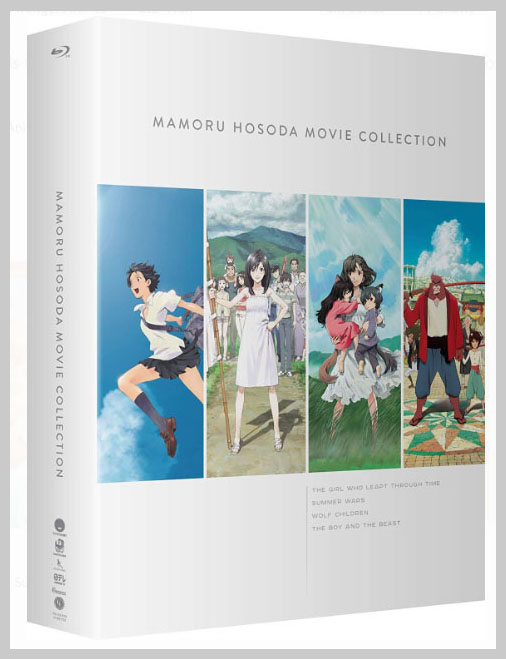
In the 12 years since the premiere of The Girl Who Leapt Through Time (2006), his first personal feature, Mamoru Hosoda has built a reputation as one of the most interesting writer-directors working in animation–as this collection affirms.
His films center on bright teen-agers who feel more interesting and complex than many of their American counterparts. Hosoda says, “I create characters from memories, but also by looking around me. Ordinary people in today’s Japan inspire me the most in making those characters. I like girls like Makoto and Natsuki–energetic, positive and a little bit mischievous!”
“The Girl Who Leapt Through Time” is a popular novel by Yasutaka Tsutsui (who also wrote “Paprika”), published in 1967. Makoto seems like a normal high school student: smart, but not brilliant, and a little klutzy. She likes to hang with her two best friends: honor student Kousuke and irreverent Chiaki. Their well-drawn relationship grounds the supernatural elements of the story,
One day, the brakes on Makoto’s bicycle fail as she’s speeding toward a railroad crossing. The mechanical gnomes on a store clock strike the hour as she’s about to collide with the train. Suddenly she finds herself back up the hill a few minutes earlier; she stumbles, striking an irate housewife. She’s still apologizing when the hour strikes and the train passes. Makoto doesn’t know what happened or why she’s still alive. When she learns that she has ability to leap through time, Makoto attempts to use her knowledge of the past to improve the present, but her strategy backfires.
Hosoda deftly uses what initially look like repeated shots to capture the moments Makoto relives through the time leaps. But as the complications multiply, Hosoda introduces minor variations into the recurring visuals: Things can’t return to exactly what they were. He said these small but significant changes were inspired by Bach’s “Goldberg Variations.”
For Summer Wars (2009), Hosoda worked with screenwriter Satoko Okudera on an original story. “I wanted to make an action film in which a crisis arises and people solve it in today’s Japanese society,” he says. “I wanted all the characters to be realistic: There are no superheroes and robots in real life,”
Math nerd Kenji Koiso knows he no superhero. He works part-time doing maintenance on the global network OZ. The avatars in the CG realm of OZ have an overripe cuteness that contrasts visually with the oppressive heat of the Japanese summer the 2D sequences suggest.
Kenji’s ecstatic when pretty Natsuki Shinohara offers him a job–until he discovers she wants him to pose as her fiancé at her great-grandmother’s 90th birthday. His effort to cope with her large, fractious family have be abandoned when the Love Machine, a malicious Artificial Intelligence program, attacks OZ. The demonic character scrambles an array of panels with his spear: Traffic lights all over Japan go out of synch; traffic grinds to a halt. Neither the Tron films nor Ready Player One suggested the link between the real and cyber worlds as effectively
Natsuki’s skill at the Japanese card game Hanafuda enables her to defeat the Love Machine, assisted by Kenji’s mathematical abilities and her cousin Kazuma’s mastery of Kung Fu and computer games. They’re not superheroes, which makes their victory more exciting than standard good-guy-to-the-rescue tales.

From “Wolf Children”
Hosoda came up with the original idea for Wolf Children (2012) and co-wrote the script with Okudera. Hana, a hard-working student at Tokyo University, falls in love with a quiet young man in her history class. He’s a wolfman: not a werewolf, but a shape-shifter out of Japanese folklore. Their relationship leads to a baby girl, Yuki, and a year later, a boy, Ame. Wolfman is a devoted husband and father, and Hana is shattered by his unexplained death.
As the children inherited their father’s shape-shifting ability, raising them in Tokyo becomes impossible. Hana moves them to a remote mountain village, where her kind heart and hard work win over her colorful neighbors. As the children age, Yuki wants to go to school and live only as a human; Ame skips school to explore the surrounding mountains as a wolf, learning from a wise, aged fox.
Like Wolf Children, The Boy and the Beast (2015), which Hosoda wrote and directed, explores how children find the teachers they need to realize their potential. “I wanted to express my wish for children to encounter different people whom they can call their ‘teachers of choice,’ people who help them mature into adults,” Hosoda explains
When sulky Kyuta runs away, he stumbles into the Juntengai, an alternate city of monsters. He meets Kumatetsu, a slovenly, hot-headed ursine martial artist. Kyuta asks for training, but they don’t form a saccharine Daniel-Mr. Miyagi bond: They squabble and learn and grow, trading roles as student and teacher. Hosoda adds, “Simultaneously, I wanted to show adults how wonderful it is we don’t have to just look back on those bygone days when we were ‘growing up’–we can keep on growing.”
Kyuta’s training enables him to confront his rival Ichirohiko–and the dark side of his own nature in a climactic battle that evokes “Moby-Dick.” Ichirohiko takes the form of a great white whale against the starry night sky. Few directors can match Hosoda’s ability to blend drawn animation and CG in striking, imaginative ways.
It may be a little early to think about holiday gifts, but the Hosoda Movie Collection would be a welcome present under any animation fan’s Christmas tree—or Menorah.

Mamoru Hosoda Movie Collection
Funimation: $82.89 Blue-ray, 4 discs
- Charles Solomon’s Animation Year End Review 2023 - December 28, 2023
- INTERVIEW: Makoto Shinkai on “Suzume” - November 27, 2023
- Interesting Portrayals of Gay Men in Manga/Anime - June 12, 2023


 November 6th, 2018
November 6th, 2018  Charles Solomon
Charles Solomon  Posted in
Posted in  Tags:
Tags: 






